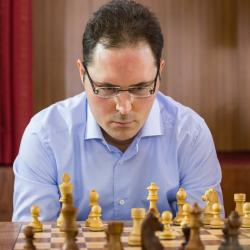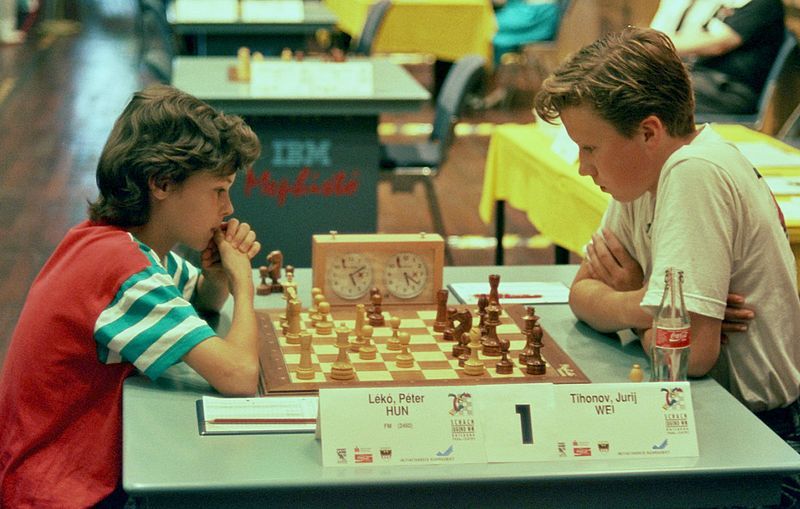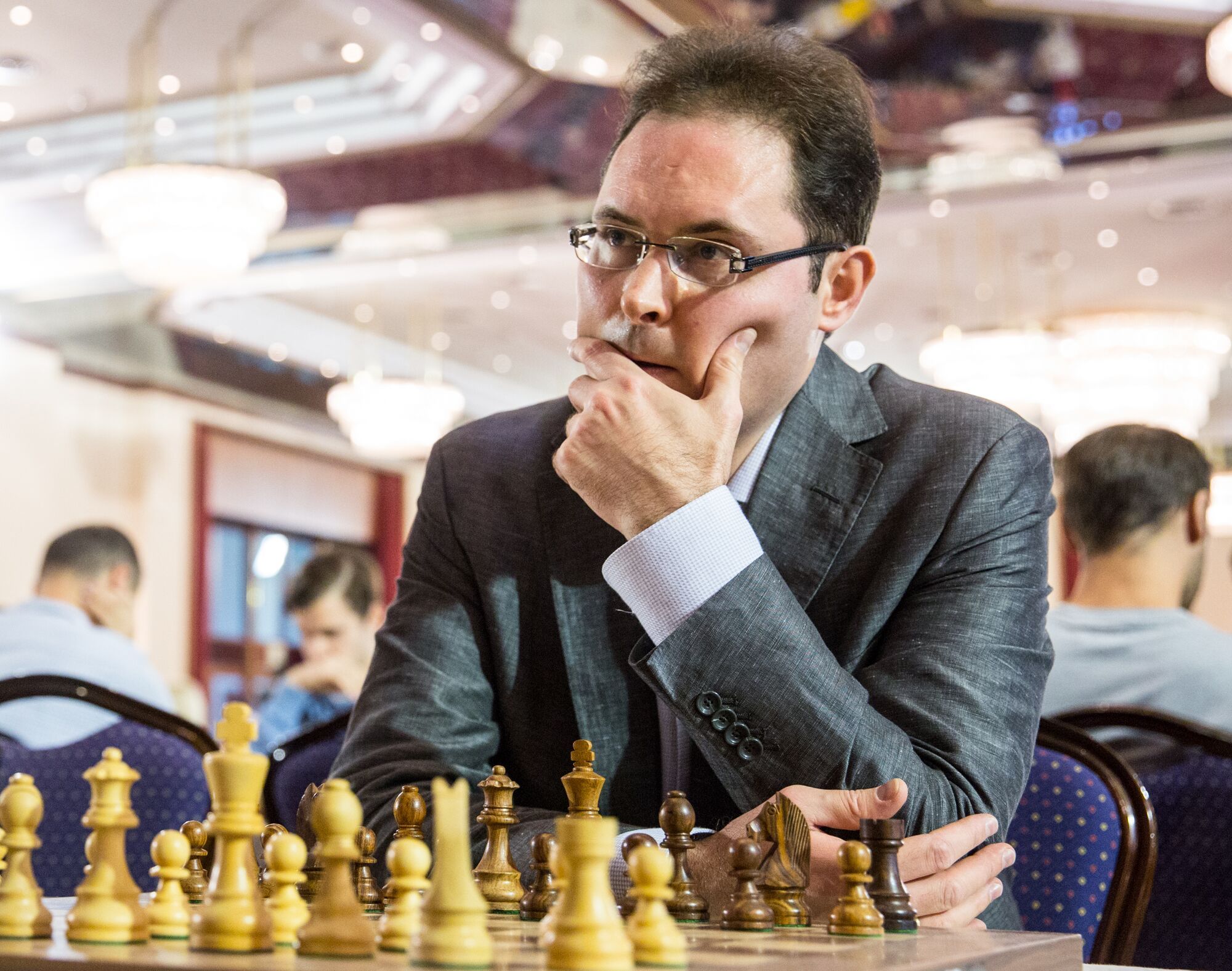GM Peter Leko

Bio
GM Peter Leko is a Hungarian super grandmaster who played for the classical world championship in 2004, losing to GM Vladimir Kramnik (under the terms of the match, despite drawing it by score).
Born in 1979, he was already an IM by 1992. GM came two years later, making him the youngest ever.
- Early Life And Career
- Dortmund 2002
- 2004 World Championship
- After The Championship Match
- Style & Legacy
Early Life And Career
Peter Leko was born to a Hungarian family in Yugoslavia in 1979. The Lekos moved to Szeged in Hungary when he was one.
Even though he learned chess slightly late at seven years old, Leko made history in 1994 as the youngest grandmaster in history to that point. GM Bobby Fischer and GM Judit Polgar achieved the title at the age of 15, but Leko did it at 14 years, four months.

Somewhat surprisingly perhaps, Leko did not win a World Junior Championship event prior to becoming a GM despite his record achievement of becoming one so early. He finished in the top four in each of the Under-10, 12, and 14 events before finally claiming gold in the 1994 Under-16 group.
As a young GM, Leko won a game against Kramnik in Belgrade in 1995. It was far from their last meeting over a board.
Leko continued to improve throughout the late 1990s. He reached a 2701 rating and 11th in the world while still in his teens. In January 2000, he entered the top 10, at number-six in the world with a 2725 rating. Except for an 11th ranking in April 2002, he remained in the top 10 on every FIDE list until January 2010.
Dortmund 2002
The 2002 tournament at Dortmund was in effect a Candidates event for the classical championship held at that time by Kramnik. It was played in July, with Leko entering as the eighth-ranked player in the world. However, he had the fourth-highest rating in the field: classical champion Kramnik (world number-two), FIDE champion GM Ruslan Ponomariov (world number-six), world number-one GM Garry Kasparov and number-three GM Viswanathan Anand did not participate.
The tournament was an unusual hybrid format. Two groups of four played a double round-robin to eliminate half the field, after which the final four players were seeded into a knockout tournament. Each group’s number-one finisher would play the other group’s number-two in the semifinal.
Leko found himself in a group with GMs Michael Adams, Evgeny Bareev, and Alexander Morozevich. Leko both won and lost against Bareev while drawing Morozevich twice, but a score of 1½-½ against Adams put Leko second in his group behind Bareev.
It was enough to advance to the knockout stage, where Leko faced GM Alexei Shirov to begin. It was a three-game rout, with the Hungarian winning twice against the Latvian-born Spaniard. Meanwhile, Bulgarian GM Veselin Topalov defeated Bareev to set up the final.
Leko’s roll continued with victories in the first two games against Topalov, who turned the tide with a game-three win, but a draw in their fourth contest delivered the tournament victory to Leko. Next up: Kramnik.
2004 World Championship
Kramnik won game one, but Leko struck in game five to even the match.
Then in game eight, Leko won with the black pieces to avenge his loss as White in the first contest. It was an amazing victory, with Leko playing the Marshall Gambit in the Ruy Lopez.
With the match going to a best-of-14, Leko needed to play even with Kramnik in the last six games to take the title. If the match ended drawn at seven points apiece, Kramnik would retain the title. (This longtime fixture of championship matches was abandoned in favor of rapid playoffs when the title was reunified in 2006.) The next five games were all drawn, meaning a sixth would make Leko the 15th classical world chess champion.

Leko had held a game-12 draw with the Caro-Kann and returned to it in game 14. Kramnik had played 3.Nd2 in the 12th game, but his situation demanded more aggression in the 14th, leading to 3.e5 for the Advance Variation. Leko pursued the common but never foolproof strategy of trading pieces to try to simplify into a draw. Even down to two pieces remaining for each side, Kramnik’s position dominated, and Leko resigned after 41 moves.
Leko joined Carl Schlechter in 1910 and GM David Bronstein in 1951 as the three players who have come closest to becoming world champion without doing so. GM Anatoly Karpov in 1987 is the fourth to draw as the challenger, but he, of course, was world champion from 1975 to 1985. Leko will be the last for as long as world championship matches feature a playoff provision, which could be for all time. Oh, so close.
After The Championship Match
Leko got his next shot at a title in 2007, this time an undisputed one after Kramnik defeated Topalov in 2006 to reunify the championship. Leko qualified for FIDE’s eight-player tournament double round-robin—the first and only time since 1948 that a tournament decided the undisputed world champion—by defeating GM Mikhail Gurevich and Bareev in matches.
As he had three years earlier, Leko scored 50 percent with a 7/14. Naturally, such a score ties a match but is only an average tournament performance. He placed fourth, two points behind the new champion Anand. Had Leko won, he would have again faced Kramnik for the world title, this time without the “classical” qualifier in 2008. Instead, Anand played and won that match.

Even at this late point in his career, Leko was the third highest-rated Hungarian player in March 2020 after GMs Richard Rapport and Zoltan Almasi. He also remains a top-100 player in the world. However, his rating began to fall in 2009, dropping below 2700 in October 2016 and hitting its lowest point of the 21st century at 2660 in January 2019. Leko did not play in any of the several Candidates tournaments of the 2011-20 decade.
Style & Legacy
Leko’s career success went beyond his youth record as a GM or the 2002-07 world championship cycle. He won several strong tournaments, including Linares in 2003, Wijk aan Zee in 2005, and a second time at Dortmund in 2008. The game below is from his 2005 Wijk victory.
Leko achieved his success largely through solid play. This got him somewhat of a reputation as a drawish player, but the results were difficult to argue with. In the opening, he was largely a 1.e4 player but varied more widely as Black, playing 1...c5 or 1...e5 against 1.e4 and the Nimzo-Indian, Grunfeld, and Queen’s Indian against 1.d4.
Overall, Leko is possibly an underrated player. Perhaps his relative lack of success in the 2010s, especially compared to the somewhat older Kramnik and Anand, is to blame.
However, he was the youngest GM in history for a time and came only a draw away from the classical world championship. Those are two massive accomplishments, yet his name is rarely mentioned among the all-time greats. While he is not in the very top best-of-the-best echelon, he was and is a fantastic grandmaster.


